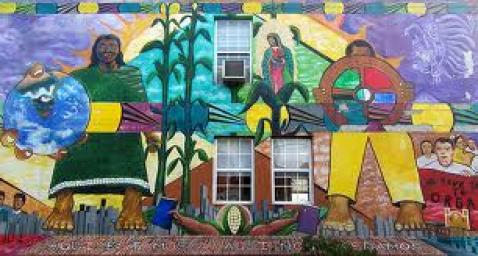A Community Changes
How do people change a community?
Chicago is a city of communities. Each community has a history. It is a history of choices. It is a history of changes. Read about one Chicago community to learn about the choices people have made there.
The community is Pilsen. People call it the “Heart of Chicago.” It started when immigrants moved here. Immigrants are people who move to another country. Many immigrants have moved to Chicago.
Immigrants settled in Pilsen. Many came from a country called Bohemia. They named the community. They called it Pilsen. That is a name from their homeland.
Many came to Chicago to find jobs. There were many factories near Pilsen. Chicago was growing. There were many jobs. People wrote to families. They told them to come to Chicago. They would find jobs. They would find friends. They would join families.
They built the things they needed. They built churches. They built schools. They started businesses. They opened restaurants. They served food that reminded them of Bohemia. They started newspapers. Their
newspapers were in their own language.
More people came there from Bohemia. The community grew. Leaders set up a place to help new immigrants. It was called Bohemian Settlement House. It opened in 1905. They helped newcomers find jobs. They helped them find homes. They made sure the newcomers had food. They helped them get medicine. Immigrants learned English at the settlement house.
Then things changed. Many people moved out of Pilsen. They moved to other neighborhoods. Businesses closed. The community got smaller.
Then more people moved into Pilsen. They came from another country. People from Mexico started to move there. They joined the churches. They opened businesses. They opened Mexican restaurants. They
started their own newspaper. Pilsen changed. There were two groups in Pilsen.
Leaders of the two groups met. They made a plan. They talked about ways to live together. They worked together. They wanted people to share. They wanted to help the community.
They thought of a way. It was a way to use art. They would make the community special. They would paint murals. A mural is a very big painting on a wall. Both groups worked together to make these great paintings. Now Pilsen has many beautiful murals. They painted them on walls. Both groups were proud.
Today, Pilsen is Mexican-American. Community groups help make it a good place. Community leaders work together. They help people build new homes. People like living there. They know their neighbors will help them. They are proud to live there.
A heritage is what you have from your past. Mexican-Americans have a rich heritage. Every August, Pilsen has a special day. It is the Fiesta Del Sol. People who used to live in Pilsen come back to visit. They see
the changes. They see their own heritage too. They see the murals.
